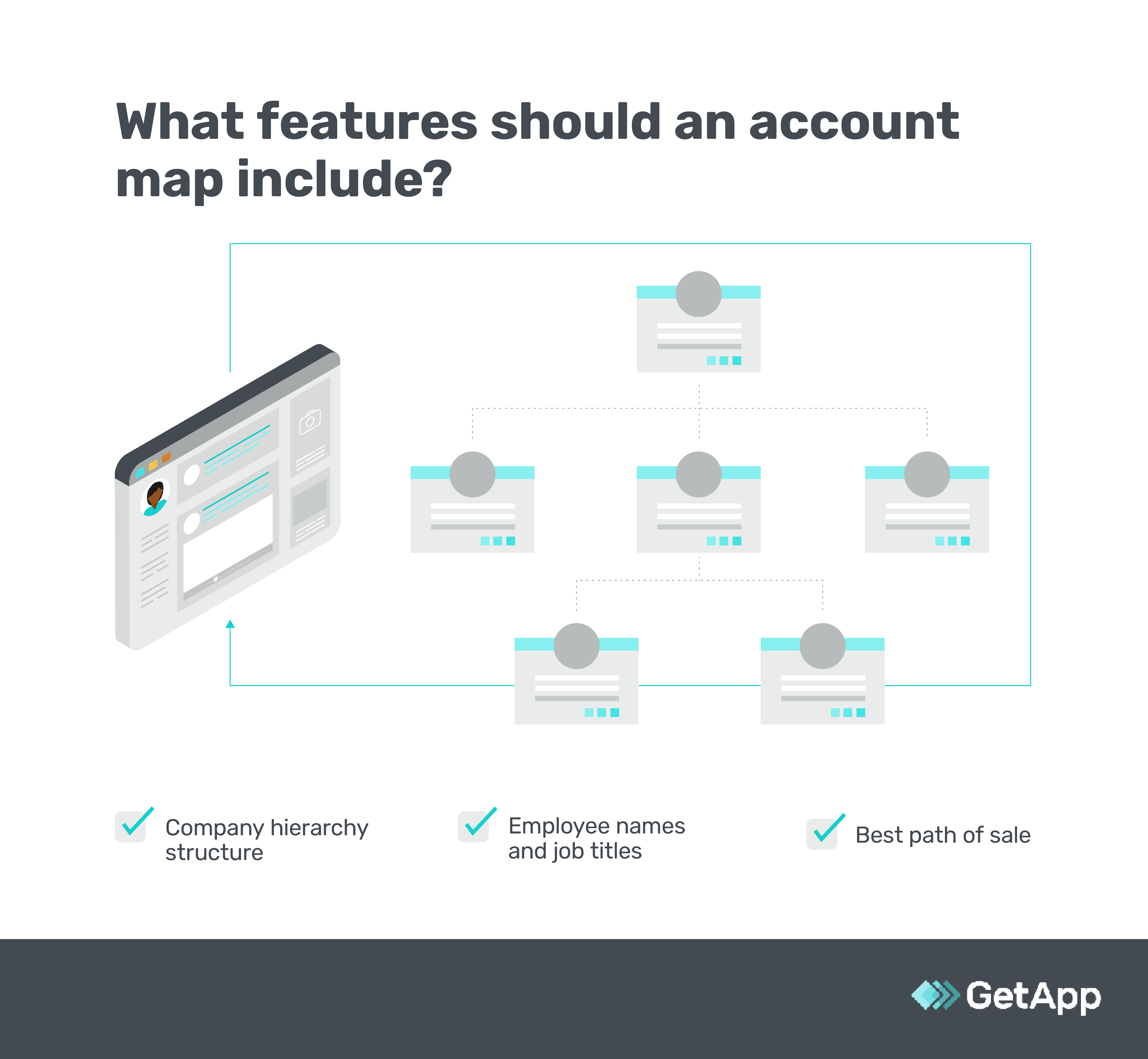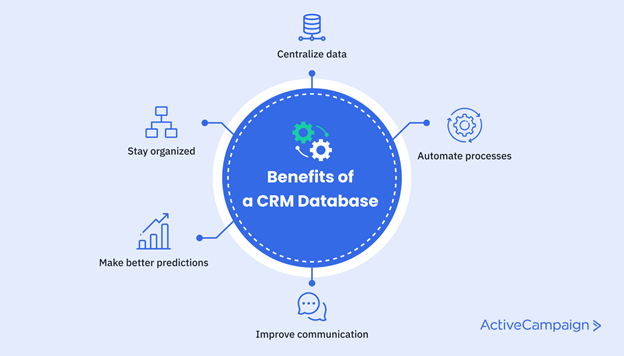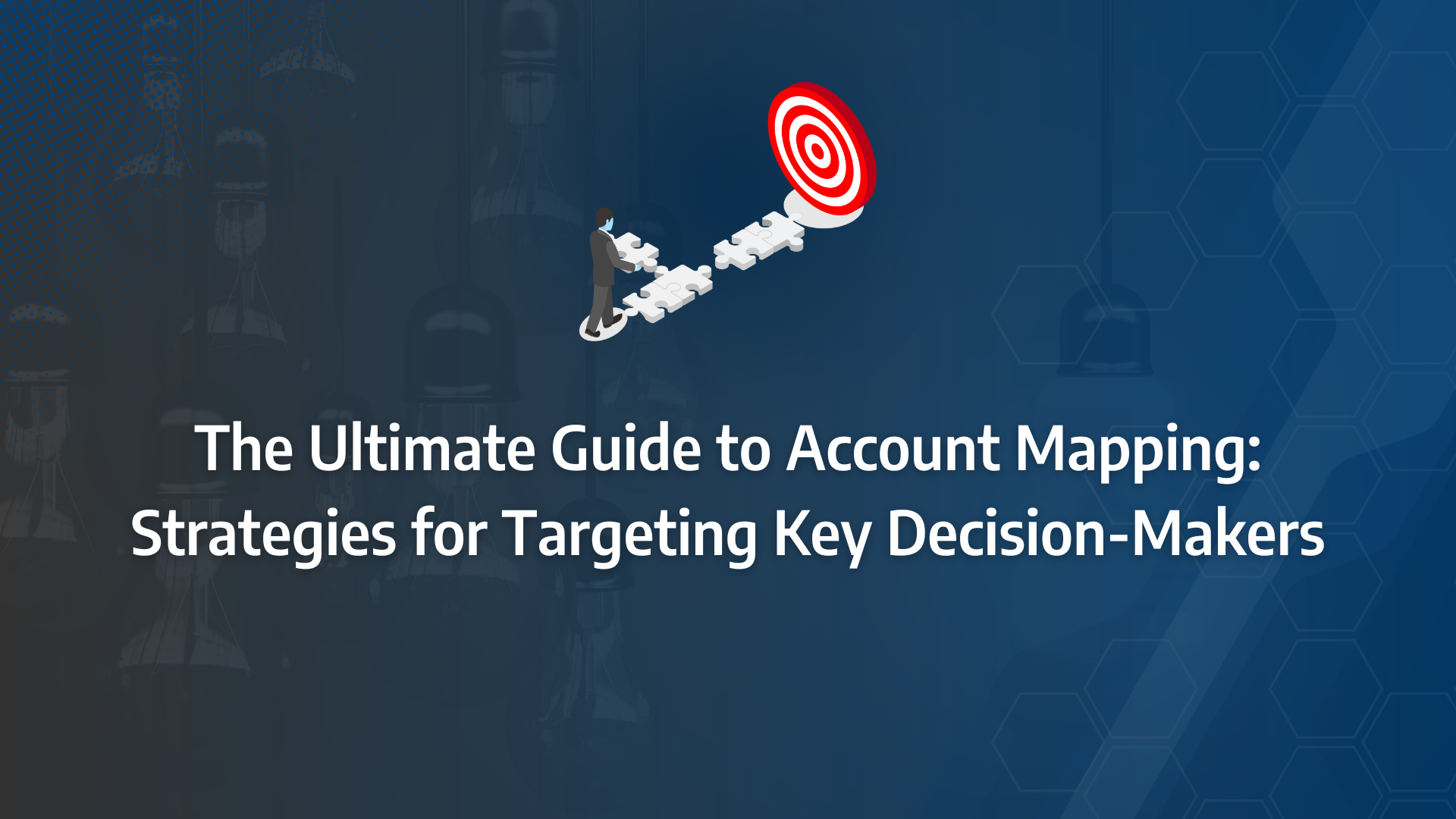B2B marketing requires a strategic approach, particularly when it comes to identifying and engaging key decision-makers within your target accounts. Account mapping is more than just a buzzword—it’s a critical tool for ensuring that your marketing and sales efforts hit the right marks.
But how do you effectively map out these accounts and create a strategy that resonates with your key targets? In this guide, we’ll delve into the frameworks and strategies that top B2B marketers use to master account mapping. You’ll discover actionable steps to align your sales and marketing teams, leverage account mapping tools, and ultimately, enhance your Account-Based Marketing (ABM) efforts.
- Leverage Account Mapping for Precision Targeting: Use account mapping to identify and prioritise key decision-makers within your target accounts, ensuring that your marketing efforts are focused on the most impactful contacts.
- Align Sales and Marketing for Unified Strategies: Strengthen the collaboration between your sales and marketing teams through shared account mapping strategies, ensuring a cohesive approach to engaging with key accounts.
- Utilise Account Mapping Tools for Visualisation: Implement account mapping tools to visually map out organisational hierarchies, helping your teams understand the decision-making pathways within key accounts.
- Segment Accounts for Customised Engagement: Break down your target accounts into segments based on their importance and potential impact, tailoring your communication strategies to address the specific needs of each segment.
- Implement Best Practices from Industry Leaders: Follow the example of successful companies that have used account mapping to drive their ABM efforts, applying their strategies to improve your own targeting and engagement processes.
- Focus on Long-Term Relationship Building: Use account mapping not just as a one-time strategy, but as an ongoing process to build and maintain strong relationships with key decision-makers over time.
What are the key benefits of account mapping in B2B marketing?
Account mapping is a vital process that involves identifying and visually charting the key stakeholders, decision-makers, and influencers within a target organisation. This approach provides a detailed understanding of the organisational structure, revealing how individuals are connected and their roles in the decision-making process. Additionally, account mapping can highlight opportunities for upselling, cross-selling, and new business development. By leveraging this visual framework, sales teams can navigate the corporate hierarchy more effectively, enabling them to craft messages that are prioritised and tailored to specific roles.
The core aim of account mapping is to gain a deep understanding of the unique personas within a target account, including their specific needs, motivations, challenges, and preferences. This understanding is critical for developing successful account-based marketing (ABM) and account-based selling (ABS) strategies. These strategies are designed to build stronger relationships and deliver personalised content that resonates with various audiences within the organisation.
What Matters Most?
From our experience, creating a comprehensive view of the customer journey across departments can reveal critical insights that inform more effective engagements. Clients typically find that integrating account mapping with predictive analytics allows for a sharper focus on high-value opportunities, enabling teams to anticipate client needs with greater precision.Get In Touch
Why Account Mapping is Essential for B2B Marketing
Account mapping is a crucial element in Account-Based Marketing (ABM) and plays a significant role in broader B2B marketing strategies. Here’s how it can be effectively used:
Timing Campaigns Strategically: By using account mapping, marketing teams can gain insights into the financial cycles of their target accounts. This knowledge allows them to plan and execute marketing campaigns during times when clients are most likely to have the budget available for new investments, increasing the likelihood of success.
Targeted Audience Segmentation: Account mapping goes beyond simply identifying key personas such as job titles, functions, seniority levels, and buyer personas, which are essential in ABM. It also enables B2B marketers to segment their audience into precise clusters based on these characteristics. This targeted approach ensures that marketing efforts are more relevant and effective, leading to higher engagement and conversion rates.
Creating Personalised Engagements: Through account mapping, teams can gain a clear understanding of the roles and needs of individual stakeholders, allowing them to create more personalised communications and offerings. This level of personalisation leads to more meaningful interactions by ensuring the right messages are delivered to the right people at the most appropriate times in the customer journey and buying process.
Crafting Effective Sales Strategies: Sales teams can leverage account mapping to develop more informed and focused strategies, thereby increasing their chances of closing deals. By completing the account mapping process, sales teams can prioritise their outreach efforts and use tailored messaging that resonates with each persona’s role in the buying process. Knowing the key decision-makers, as well as other important figures like executive sponsors, influencers, champions, gatekeepers, and blockers, is invaluable for driving sales success.
Building Stronger Relationships: Building and maintaining strong client relationships is crucial for customer retention and encouraging repeat business. Account mapping helps in forming genuine connections with key decision-makers and influencers, demonstrating the sales team’s understanding of the organisation’s specific challenges and needs.
Enhancing the Customer Experience: By understanding the customer’s pain points and goals, businesses can better align their solutions to meet client needs, leading to an improved overall customer experience. For new business opportunities, this alignment fosters confidence in the customer’s decision-making process. When it comes to cross-selling or upselling, existing clients who already view the business as a trusted partner will be more open to exploring additional solutions. The aim is to strengthen these relationships and extend similar connections to other departments within the organisation.
Proactively Managing Risks: Account mapping allows businesses to identify potential risks or obstacles in the sales process and develop proactive strategies to mitigate them. Certain personas within an organisation may act as barriers to closing a deal. By understanding the concerns of these individuals, sales teams can navigate these challenges more effectively. Blockers often include finance teams or mid-level employees tasked with researching solutions. Recognising the role each person plays in the buying process enables sales teams to address objections strategically, reducing risks and increasing the chances of a successful sale.
Essential Components for Effective Account Mapping
When you’re detailing the structure and key players within a prospective organisation, capturing the right information is vital. Below is a revised guide to what should be included in your account mapping tool for each contact within the target organisation:
- Role and Position: Document each individual’s job title, their role within the company, the department they belong to, and their level of influence. Understanding their place in the company hierarchy is critical to crafting an effective engagement approach.
- Identity Details: Ensure that you have accurately captured the names of key contacts—this precision is crucial in making a positive impression during interactions. Including a headshot can also help in personalising communications, adding a human touch to your outreach.
- Contact Information: Gather comprehensive contact details such as work phone numbers, extensions, email addresses, mobile numbers, LinkedIn profiles, and CRM records. The more thorough your information, the better your ability to connect and engage effectively.
- Location Data: For large organisations with multiple offices, knowing the specific country, city, and office location associated with each contact is beneficial. This geographical information can be particularly useful when planning strategies for upselling or targeted outreach.
- Mapping Organisational Relationships: Construct a detailed chart that outlines the formal and informal relationships within the organisation. While a basic hierarchy provides a foundation, deeper insights are gained by understanding how each contact influences the company’s decision-making process.
- Personalised Insights: Collect additional details, such as each contact’s personal goals and professional expertise. This information allows for a more customised approach in your communication strategy, making your outreach more resonant and effective. You can store this information in custom fields within your CRM or mapping tools to enhance your account mapping efforts.

Types of Account Mapping
Understanding the different approaches to account mapping is crucial. The term “account mapping” can refer to two distinct processes: individual account mapping and partner account mapping.
Individual Account Mapping:
This process involves mapping a single prospect or customer to fill in crucial information about accounts in your sales pipeline. For instance, if your dream customer is the logistics division of Big Box Store, Inc., you would gather details about top decision-makers and other relevant data to close the deal. This might involve using a spreadsheet or chart to compile information from sources like LinkedIn or consulting firms.
Goal: To gain an intimate understanding of a single account, advancing them through your sales funnel or enhancing retention.
Partner Account Mapping:
Partner account mapping involves comparing your account lists with those of your partners to identify new opportunities. This type of mapping can drive significant business growth by accelerating deals, improving retention, and creating new business opportunities that might be challenging or impossible to achieve independently.
Goal: To drive exponential business growth through various strategies with partners that facilitate faster deals, enhanced retention, and new business ventures.
Step by Step Guide to Effective Account Mapping
Step 1: Focus on the Right Accounts
Gathering in-depth account details is essential but can be time-consuming. Begin by confirming that your ideal customer profile (ICP) is clearly defined. With a solid understanding of your key customers’ challenges, you can develop a targeted account list (TAL). This list should be where you focus the majority of your resources. If you’re starting from scratch, Albacross offers strategies to create an initial TAL. A CRM system like Close can help you prioritise accounts, using criteria such as potential deal value, probability of closing, and expected close dates.
Step 2: Develop an Organisational Structure Map
Start by outlining the formal organisational hierarchy of your target company. This can be done manually by entering data from your CRM or by exporting account information into a CSV file and using a chart creation tool. Venngage or Lucidchart are excellent tools for turning spreadsheet data into detailed organisational charts. Other data visualisation and relationship mapping tools can also be useful in creating comprehensive account maps. If you lack sufficient background on the company, and if resources allow, consider using paid services like DiscoverOrg or Detective by Charlie to generate an organisational chart for you.
Pro Tip: If you have a good relationship with a contact within the account, consider asking them directly for an organisational chart. Expressing interest in their company’s internal structure can encourage them to assist you. While many sales professionals may hesitate to make this request, it can yield valuable insights.
For new accounts, directly asking for an org chart might be too forward. In such cases, consider collaborating with companies offering complementary products in the same market. These partners may have already mapped the industry and can provide essential information to help you target key accounts.
Companies with similar ICPs and TALs, identified during your initial steps, make strong partners. Tools like Crossbeam can help you identify overlapping customers while keeping your data secure.
Step 3: Collect and Categorise Information; Identify Key Contacts
Enhance the visual map you created in the previous step by diving deeper into the profiles of your contacts. Understand their roles and their views on your product. If someone is pivotal in the decision-making process, gather as much information as possible about their professional and personal background.
Record this information in your CRM, clearly indicating who is involved in the buying process. Label contacts with specific roles, such as “influencer” or “decision-maker.” Colour coding these roles (e.g., green for decision-makers) can help you quickly identify each contact’s significance within the process.
Source: Harvard Business Review
Step 4: Chart the Path to a Successful Sale
Today’s sales processes are complex, and purchasing decisions often do not follow a clear hierarchy. If you encounter resistance early in the process, it might be tempting to move on to other prospects.
However, your account map can help you identify who actually holds the purchasing authority and pinpoint the key relationships that can influence the final decision. Your goal is to understand these dynamics and navigate them to build consensus and close the sale. You may need to adjust your map to highlight which connections are crucial in overcoming objections and driving the deal forward.
Step 5: Tailor Your Communication Strategy
With key accounts and decision-makers identified, along with an understanding of their pain points and preferred communication channels, it’s time to personalise your outreach.
In-Person or Virtual Events: Organise events and invite key stakeholders, encouraging them to involve colleagues to enhance engagement within the target account.
Podcasts and Webinars: Invite industry leaders from your target accounts to participate in your company’s webinars or podcasts, creating a platform for deeper engagement.
Direct Mail Campaigns: In a digital world, direct mail can help your company stand out. Send customised packages to key decision-makers and follow up with targeted digital outreach to reinforce your message.
Website Customisation: Use tools like Sitecore to personalise the web experience for visitors from target accounts, offering tailored content such as custom hero images, industry-specific landing pages, and relevant navigation options.
Our Tactical Recommendations
To enhance your account mapping efforts, leveraging social networks for insights on key stakeholders often provides a competitive advantage. We frequently find that regularly reviewing and adjusting account mapping strategies helps us stay agile in a changing market. Additionally, employing advanced technology solutions to automate data collection can significantly streamline the mapping process, allowing teams to focus on strategic decisions rather than data gathering.Get In Touch
Account Mapping Tactics
Utilise a Partner Collaboration Platform
In the past, account mapping often meant manually handling spreadsheets, which was both laborious and prone to inaccuracies. Today, using a Partner Collaboration Platform (PCP) can dramatically enhance the efficiency of this process, particularly for mapping partner accounts, making it up to ten times faster. If you’re still relying on spreadsheets, it’s important to note that data can quickly become outdated once exported. Even with advanced tools, some level of inaccuracy is unavoidable, so it’s crucial to regularly validate your data.
Once you have completed the mapping of partner accounts, there are several strategic options available. The most common paths include launching co-selling initiatives or co-marketing campaigns to maximise the insights gained.
Harness the Power of Inquisitive Sales Techniques
Sales methodologies often stress the value of “inquisitive selling,” where the sales process is driven by asking strategic questions that help prospects uncover their own need for your product.
This approach makes collecting information for account mapping both effective and natural. By framing questions around a customer’s pain points, team dynamics, management expectations, and peer interactions, you can gather valuable data without appearing intrusive. This technique ensures you collect the necessary insights to enrich your account map while keeping the dialogue engaging.
Maintain High Ethical Standards
Maintaining integrity in account mapping is crucial. Unfortunately, some businesses resort to questionable methods to gather internal information, such as misleading assistants about who they are, pressuring contacts to reveal more than they should, or acquiring data through illegal means. These practices not only undermine trust but also pose significant risks if discovered. Upholding ethical standards in all interactions is vital for building long-lasting relationships that are far more beneficial than any short-term gains from unethical practices.
Leverage CRM Systems for Account Mapping
A successful account mapping strategy relies heavily on the effective use of Customer Relationship Management (CRM) systems. A well-integrated CRM, such as Salesforce in conjunction with ARPEDIO’s Account-Based Selling Platform, does more than store data—it centralises account information and provides analytical tools that turn data into actionable insights. These systems are indispensable for monitoring relationship development, identifying sales patterns, and ensuring seamless communication across departments.

Focus on Data Accuracy and Quality
The success of account mapping is directly linked to the quality of your data. The accuracy and reliability of your data have a significant impact on your strategic decisions and your ability to personalise client interactions. Organisations must invest in rigorous data management practices, which include regular data cleansing, thorough validation checks, and comprehensive training for staff on the importance of maintaining data quality. Ensuring that all data entered into your CRM is accurate is essential for making informed decisions.







